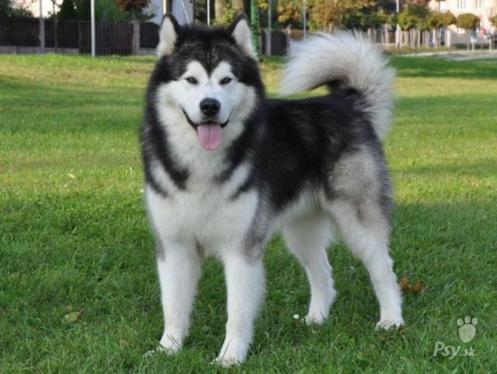
The Breed History
The Malamute is one of the ancient Arctic Sled Dogs, and they
are the Native sled dog of Alaska. Their name derives from the
Innuit tribe/village (Mahlemuts) that kept them. The Samoyed and
Siberian Husky of Russia are cousin breeds. First registration in AKC
occurred in 1935. Within the breed are two types based on size and
color. M’Loot are larger than the Kotzebue strain, and the Kotzebue
consist of dogs with only wolf-gray coat color.
Breeding for Function
Hauling heavy sleds was their primary function. They are still
popular as sled racing dogs, and as companion animals. Their forte
is in pulling weight, not in their speed, but due to their stamina,
they excel at long distance racing.
Physical Characteristics
Height at Withers: female 23" (58.5 cm), male 25" (63.5 cm).
Weight: females 75 lb (34 kg), males 85 lb (38.5 kg).
Coat: They blow their coats twice annually but are relatively low
shedding during the rest of the year. They have low bathing and
grooming needs since they tend to groom like a cat. They have a
very dense double coat with a short (1-2" or 2.5-5 cm) dense wooly
soft undercoat and very dense stand out coarse guard hairs in
the outer coat that are straight. There are distinct face markings
including a face of white or white with a bar or mask. Blue eyes
disqualify except in red color dogs, where they are pigmented
brown; the palpebral margins, lip margins and nose are black.
Coats are commonly gray in different shades, black, red, and sable.
All of these have points and markings in a prescribed pattern of a
different color. The only solid dog allowed is a white one. Usually
most of the underside and the lower limbs of the dog are white.
Longevity: 12 years.
Points of Conformation: The dog is compact, very muscular,
with high alert head carriage and possesses a deep thorax (1/2
the height of the dog) with well-sprung ribs. Head is broad, small
triangular ears are held erect or pricked up when alert and they are
set well back on the skull. Sometimes while running the ears are
seen folded back and down. Medium-sized eyes are almond shaped,
and dark brown in color. The muzzle gradually tapers. Their tail is
set high, thickly covered in hair and sits a plume over the topline.
Limbs are heavily boned and well muscled, and not bowed. Gait is
true and tireless, with long powerful stride and excellent agility.
Neck is short, muscular, and has a moderate arch. Topline is straight
but slopes down towards the rear of the dog. The feet are large and
possess large thick pads, with plenty of hair between the toes. Toes
are well arched, and compact. Dewclaws on the rear are removed.
Recognized Behavior Issues and Traits
Terms used to describe this Breed include: active, friendly, and
good with children. Also they are loyal, but may fight with other
dogs unless socialized, may be strong on the leash, and early
obedience training is important since these dogs can be a bit
stubborn and are easily bored.
They need a lot of exercise and mental stimulation. They will
enjoy gentle children, though early socialization to children is
recommended. Other traits include needing lots of human contact,
and not considered a good watchdog. They may dig so it is advised
to bury fence below grade and make it high (6’) and sturdy.
They have low barking tendency but are very vocal with talking
noises and may howl.
Tolerate heat OK if given shade and cool water.
Normal Breed Variations
The Alaskan Malamute is a breed with a predisposition to higher
eosinophil counts or certain eosinophilic diseases. Two of the more
common disease causes of canine hypereosinophilia are pulmonary
infiltrates with eosinophils (PIE) and gastrointestinal disease.
If they have snow nose (pink pigment on black nose), they are more
prone to skin cancer and sunburn in the low pigment area. Snow
nose may disappear in the summer.
Drug Sensitivities
None reported
Inherited Diseases
Hip Dysplasia: Polygenically inherited trait causing degenerative
joint disease and hip arthritis. OFA reports 11.5% affected.
Elbow Dysplasia: Polygenically inherited trait causing elbow
arthritis. OFA reports 3.2% affected.
Chondrodysplasia with Stomatocytosis (also referred to
as Dwarfism or CHD): Autosomal recessive disorder, causing
short-limbed dwarfism and hemolytic anemia. Chondrodysplasia
Certification Registry of AMCA - examines a 5 generation pedigree
- to check for all test-bred normal ancestors.
Polyneuropathy: Two forms are reported in the breed. It is
unknown if they are related to each other genetically. Hereditary polyneuropathy is an autosomal recessive disorder with an age of
onset between 7-18 months of age. It causes progressive posterior
ataxia, exercise intolerance, megaesophagus, atrophy of shoulder
and thigh muscles, and hyporeflexia. Another form, idiopathic
polyneuropathy, causes a distal sensorimotor polyneuropathy in
young mature dogs. Mode of inheritance has not been determined.
Clinical signs included progressive paraparesis, synchronous pelvic
limb gait, exercise intolerance, hyperesthesia, hyporeflexia, muscle
atrophy, and tetraplegia. Diagnosis and differentiation between
these two disorders is based on electromyography or peripheral
nerve biopsy.
Cone degeneration (CD): A rare, autosomal recessive condition,
causing day blindness. Onset approximately 8 weeks of age. Caused
by a mutation in the CNGB3 gene. Affected dogs should not be
bred. A direct genetic test is available.
Patella Luxation: Polygenically inherited laxity of patellar ligaments,
causing luxation, lameness, and later degenerative joint disease.
Treat surgically if causing clinical signs. Too few Alaskan Malamutes
have been screened by OFA to determine an accurate frequency.
Disease Predispositions
Hypothyroidism: Inherited autoimmune thyroiditis. 11.1% positive
for thyroid auto-antibodies based on testing at Michigan State
University. (Ave. for all breeds is 7.5%).
Persistent Pupillary Membranes: Strands of fetal remnant
connecting; iris to iris, cornea, lens, or involving sheets of tissue.
The later three forms can impair vision, and dogs affected with
these forms should not be bred. Identified in 8.03% of Alaskan
Malamutes CERF examined by veterinary ophthalmologists between
2000-2005.
Posterior Subcapsular Cataracts: Onset around one year of
age. Slowly progressive; rarely leading to blindness. CERF does
not recommend breeding any Alaskan Malamute with a cataract.
Identified in 7.56% of Alaskan Malamutes CERF examined by
veterinary ophthalmologists between 2000-2005.
Distichiasis: Abnormally placed eyelashes that irritate the cornea
and conjunctiva. Can cause secondary corneal ulceration. Identified
in 2.05% of Alaskan Malamutes CERF examined by veterinary
ophthalmologists between 2000-2005.
Retinal Dysplasia: Focal folds and geographic retinal dysplasia are
seen in the breed. It is questionable whether focal folds can lead
to disease, however dogs with the geographic form should not be
bred. Identified in 1.17% of Alaskan Malamutes CERF examined by
veterinary ophthalmologists between 2000-2005.
Alopecia-X (Coat Funk): Progressive, symmetrical, non-pruritic
truncal hair loss usually beginning in early adulthood. ACTH, LDDS,
and thyroid panel results are normal. Elevated blood concentrations
of 17-hydroxyprogesterone (17-OHP) have been seen post ACTH
stimulation. Oral trilostane reversed the condition in some cases.
The disorder appears familial.
Glaucoma: An elevation of intraocular pressure (IOP) which,
when sustained, causes intraocular damage resulting in blindness.
Diagnose with tonometry and gonioscopy. CERF does not
recommend breeding any Alaskan Malamute with glaucoma.
Lipid Corneal Stromal Dystrophy: A non-inflammatory corneal
opacity (white to gray) present in one or more of the corneal layers;
usually inherited and bilateral. Identified in 1.03% of Alaskan
Malamutes CERF examined by veterinary ophthalmologists between
2000-2005.
Canine Zinc-Responsive Dermatosis: Familial form identified in
the breed, characterized by erythema, alopecia, scales, and crusts
that primarily affect the head. Diagnosed by skin biopsy. Life-long
zinc supplementation is usually necessary.
Isolated Case Studies
Osteochondromatosis (Multiple Cartilaginous Exostoses):
Several case reports of young dogs with cervical pain, paresis,
and or proprioceptive deficits. Focal lesions may be corrected
surgically.
Juvenile Nephropathy: Multiple case reports. Kidney disorder
identified in 3 littermates. Presented in renal failure between 4-11
months of age.
Factor IX Deficiency (Hemophilia B): Identified in a 6 month-old
dog with a two week history of bleeding from an oral wound. Factor
IX activity was only 1.3% of normal. Factor VII deficiency has also
been reported in the breed.
Myelodysplasia: Case study of weakness of all 4 limbs in an adult
dog. No CT or myelographic abnormalities, but diffuse spinal cord
myelodysplasia and edema found on necropsy.
Paraoesophageal Hiatal Hernia and Megaoesophagus: Report
on a 3 week old dog with regurgitation. An oesophagopexy and a
bilateral gastropexy were performed, and the dog gained weight
normally.
Maxillary Ameloblastic Carcinoma: A 3-year-old female Alaskan
Malamute with a painful, ulcerated mass of the right maxilla was
diagnosed with ameloblastic carcinoma. Histologic examination
showed a neoplastic proliferation of palisading cells distributed
irregularly in cords. The dog was alive 2 years after hemi-maxillectomy.
Cryptorchidism, Cutaneous Lupus Erythematosus, Diabetes
Mellitus, Epilepsy, Gastric Dilatation-Volvulus, Hemivertebra,
Keratoconjunctivitis Sicca, Macrocytosis/stomatocytosis,
Muscular Dystrophy, Narcolepsy, OCD-shoulder, Optic nerve
hypoplasia, Panosteitis, Patella luxation, Portosystemic shunt,
Progressive retinal atrophy, Pulmonic stenosis, Retained teeth,
Ulcerative keratitis, Uveal hypopigmentation, Uveodermatologic
syndrome, Ventricular septal defect, and von Willebrand’s
disease are reported.
Genetic Tests
Tests of Genotype: Direct test for color alleles is available from
VetGen.
Direct test for CD is available from Optigen.
Tests of Phenotype: CHIC Certification: Required tests are; hip
radiograph and CERF eye examination. Optional recommended
testing; thyroid profile including auto-antibodies. (See CHIC
website: caninehealthinfo.org)
Also recommend elbow radiographs, patella evaluation and cardiac
evaluation.
Miscellaneous
- Breed name synonyms: Malamute, Alaskan Malemute, Malemute
- Registries: AKC, UKC, CKC, KCGB (Kennel Club of Great Britain),
ANKC (Australian National Kennel Club), NKC (National Kennel Club).
- AKC rank (year 2008): 57 (1,737 registered)
- Internet resources: Alaskan Malamute Club of America Inc.:
alaskanmalamute.org
Alaskan Malamute Research Foundation:
malamutehealth.org
Alaskan Malamute Club of Canada:
quadrant.net/amcc/
Alaskan Malamute Club of the UK:
alaskanmalamute.org.uk
Photo Gallery of Breed - Alaskan Malamute - Dog Breed

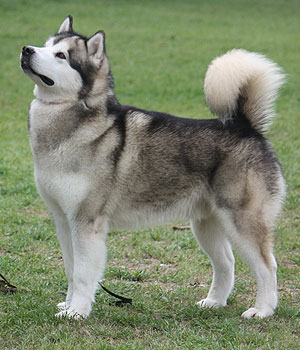


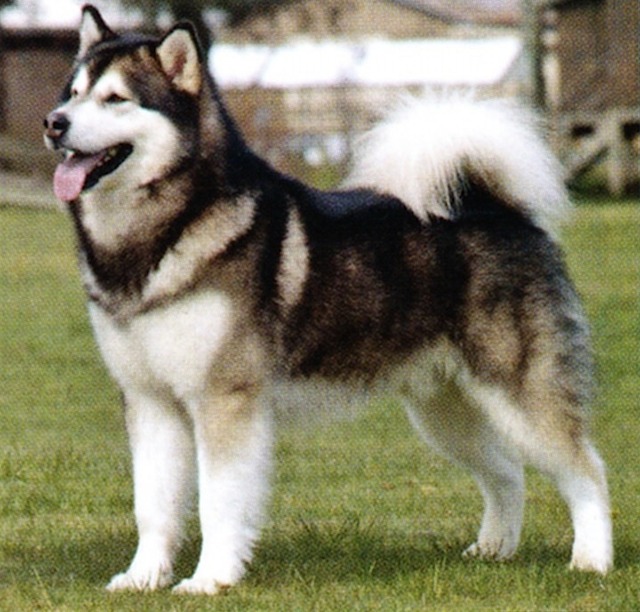

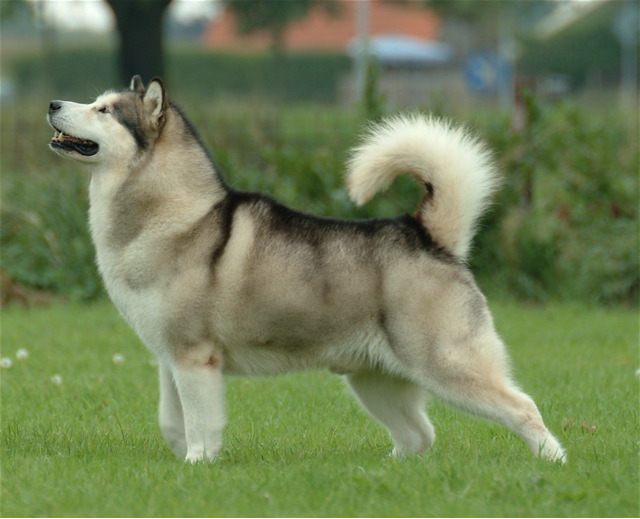
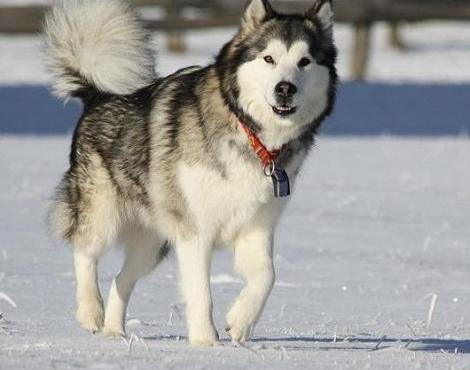
 Animalia Life
Animalia Life